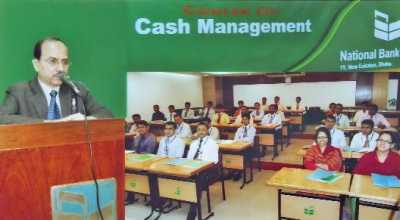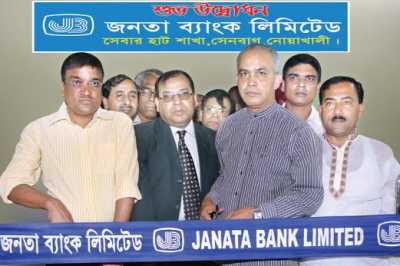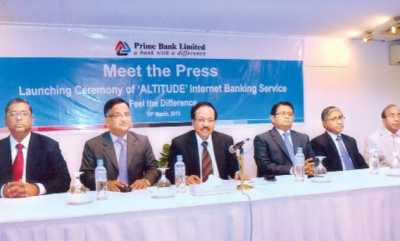Banking
NBL holds training course for junior officers
 M Badiul Alam, Additional Managing Director of National Bank Limited, addresses the inaugural function of a foundation training course of the Bank in Dhaka recently. National Bank Training Institute of the Bank conducted the course for its Junior Officers (Cash).
M Badiul Alam, Additional Managing Director of National Bank Limited, addresses the inaugural function of a foundation training course of the Bank in Dhaka recently. National Bank Training Institute of the Bank conducted the course for its Junior Officers (Cash).
National Bank Limited (NBL) held a training course for its Junior Officers (Cash) in Dhaka recently.
M Badiul Alam, additional managing director of the Bank, inaugurated the function attending as chief guest, said a press release.
Principal of National Bank Training Institute, which is conducting the course, M Majibur Rahman and NBL Senior Assistant Vice President Zahir Uddin Mohd Babar, and senior faculty members of the institute, were also present at the function, among others.
A total of 35 Junior Officers (Cash) are taking part in the training.
The Daily Sun/Bangladesh/ 18th March 2012
JBL opens branch in Noakhali
 Dr. Jamal Uddin Ahmed, director of Janata Bank Limited, inaugurating the 876th branch of the Bank at Sebarhat in Noakhali recently.
Dr. Jamal Uddin Ahmed, director of Janata Bank Limited, inaugurating the 876th branch of the Bank at Sebarhat in Noakhali recently.
Janata Bank Limited (JBL) has opened its 876th branch at Sebarhat in Noakhali recently.
Dr. Jamal Uddin Ahmed, director of JBL, formally inaugurated the branch as chief guest, said a press release.
Md Abdus Salam, deputy managing director of JBL, presided over the function.
Among others, M Sirajul Islam, general manager of head office of JBL, SM Masud-ul-Alam, general manager of Comilla division, M Mokhlesur Rahman, deputy general manager of Noakhali Area Office and local business holders, among others, were also present on the occasion.
The Daily Sun/Bangladesh/ 18th March 2012
Prime Bank launches internet banking
 Managing Director of Prime Bank Limited Md. Ehsan Khasru seen at the launching of ‘Altitude’ internet banking service at a city hotel recently.
Managing Director of Prime Bank Limited Md. Ehsan Khasru seen at the launching of ‘Altitude’ internet banking service at a city hotel recently.
Prime Bank has been enhancing technology usage in its banking services with the demand of time.
Managing Director of Prime Bank Limited Md. Ehsan Khasru said at a press conference at a city hotel on the eve of launching ‘Altitude’ internet banking service recently.
The IT division of the Bank developed the software, he said adding, “This is secure, safer and faster than the internet banking used by the other Banks of the industry.”
The Daily Sun/Bangladesh/ 18th March 2012
The future of Asian banking
This week was my first visit to Bangkok since the floods in December. The city seems to have recovered and the economy is on the mend. After an estimated 0.1 percent growth in real GDP in 2011, the International Institute of Finance (IIF) is forecasting a robust 7 percent growth recovery in 2012, helped by a multi-year fiscal stimulus that would bring the fiscal deficit to an estimated 5.5 percent of GDP for the fiscal year 2011-2012.
The package of fiscal stimulus included a 40 percent hike in minimum wages from April and an aggressive cut in corporate income tax rate from current 30 percent to 23 percent and a further cut to 20 percent for 2013. This would put Thai corporate tax rate closer to those of its neighbours.
The combination of increase in minimum wage rates and generous price support programme for rice mean that the government is serious about tackling income gaps and pushing consumption.
The purpose of the Bangkok trip was to debate the future of Asian banking business models. The central question is how to recycle Asian savings within Asia. Because of its demographics and prudence in consumption, East Asia has always run a net current account surplus, with its accumulation in savings placed largely in the advanced markets. Why can't some of these savings be used to fund much needed infrastructure within the region?
In 2003, Dooley, Folkerts-Landau and Garber named the current cross-Pacific arrangement Bretton Woods II, where Asia funded the US current account deficit by reinvesting its savings back in the advanced markets. This arrangement can also be called the Grand Bargain.
Basically Asia swapped dollars for jobs for the youth entering the labour force and the exploitation of its natural resources. The Grand Bargain is ending as Asians realise that their holdings of dollars may be exposed to future depreciation and that Asian labour force and natural resources should not be cheap forever.
The Grand Bargain had implications for the advanced country banking business models. A deficit country will very soon find that its banking system must have loans/deposit ratios running higher than 100 percent, because the excess consumption has to be funded by credit.
In Asia, the average loans/deposit ratio is lower than 100 percent, because savings are larger than debt. The American banking system had to shift from retail banking into a wholesale banking system, relying on securitisation of its assets (mortgages and loans) and selling them into the global market to fund its loan book.
Quite a lot of AAA-rated securities ended up in European portfolios, because the prudent Asians stuck mostly to Treasuries. Thus, when the subprime crisis erupted in 2007, the European banks were one of the bigger victims.
There are good reasons why US and European banks evolved into leveraged wholesale banks turbocharged by derivative markets. Ninety percent of OTC derivative trading in the US are dominated by five large banks. Europe as a region accounts for 70 percent of total global interest rate derivative trading.
The Atlantic banks went into proprietary trading and financing engineering because by the 1980s, under competition from the Japanese banks, net interest margin business (basically the margin between lending rate and deposit rates) became less and less profitable.
This shift out of traditional retail banking business was also due to the free market ideology to reduce market friction to zero by lowering transaction costs (such as transaction taxes and commissions). In the old days when brokers made money from fat commissions, they were willing to provide research for their customers.
When margins became near zero with computerised trading, securities firms engaged more and more into proprietary trading and leveraged trading in order to make money. Good quality research became scarce. Banks made more money from “pushing” derivative products to their retail investors, because they could earn more fees up-front and from granting credit to their customer from leveraged trading.
The combination of proprietary trading and leveraged derivative financial engineering morphed banking business away from being a trusted agent of the real sector into a competitor or principal that may trade sometimes in conflict against the interest of its customers. The financial sector became a principal in its own right, with total assets larger than the real sector and therefore Too Big to Fail.
This change in culture was exemplified by the remarkable Op-Ed by Greg Smith, a former executive director in Goldman Sachs, published in the International Herald Tribune on March15, 2012, which I read on the plane back to Hong Kong. He basically highlighted the debate whether one should be making money for the bank or making money for the client.
Because Asia as a whole did not run into deficit, the banking system has not strayed from its retail banking roots. After the painful lessons of the 1997-98 Asian financial crisis, Asian regulators have been much more cautious in allowing Asian banks to go the derivative route.
The game is changing dramatically because Asian interest margins are also beginning to be squeezed as competition intensifies. Some Asian banks are already being rapped on the knuckles for not paying enough attention to client suitability in selling inappropriate wealth management products to customers. So the debate on whether Asian banks should make more money from capital market business is very much on the table.
This raises a fundamental question which the current global regulatory reforms have not addressed. I have gone on record to say that if green engineers are paid less than financial engineers, will we expect a green economy to emerge before asset bubbles? Similarly, if banks are to serve their real sector customers better, what policies are required to induce them to make more money from real customer service than leveraged proprietary trading?
This means that regulators need to pursue less what banks should not do, but what business models are appropriate for the banks to serve the real sector better? This obviously requires the regulators and the industry to have a better conversation than the current lines of engagement.
The Daily Star/Bangladesh/ 18th March 2012
Southeast Bank declares 15pc cash, 5pc stock dividend
The shareholders of Southeast Bank Ltd by their unanimous votes approved 15 per cent cash dividend and 5 per cent stock dividend to the shareholders and the financial statements of the Bank for 2011. They also re-elected directors and approved appointment of external auditors for the year 2012, says a press release.
The approval came at the 17th annual general meeting (AGM) of the Bank that was held on Thursday at Officers’ Club, Dhaka. Bank’s directors, sponsors and large number of shareholders attended the meeting. Alamgir Kabir, chairman of the Bank, presided over the meeting.
Mahbubul Alam, managing director of the Bank, highlighted the Bank’s operational performance in 2011 and outlined the future plans and programmes to be undertaken by the Bank to boost up operational efficiency and profitability of the Bank.
The AGM witnessed a lively discussion on the Bank’s operational performance. The Southeast Bank earned an operating profit of Tk 6,085.66 million in 2011. As on December 31, 2011 Bank’s total deposits amounted to Tk 127,178.22 million, its total assets reached Tk 158,078.59 million, Earning Per Share was Tk 2.33, Net Asset Value per share was Tk 23.30 and Net Operating Cash Flow per share was Tk 14.40.The Price Earning Ratio of the Bank was 12.88.
The capital and reserves of the Bank soared to a record high of Tk 19,000.06 million as on December 31, 2011. The Bank maintained a capital adequacy ratio at 11.46 per cent as on 31st December, 2011 against requirement of 10 per cent set by Bangladesh Bank.
Credit Rating Information and Services Limited rated the Bank AA- (Double A Minus) for the long term and ST-2 for the short term based on the financial statements of the Bank for 2010.
The Daily Independent/Bangladesh/ 16th March 2012



